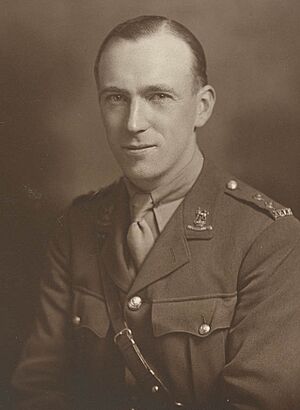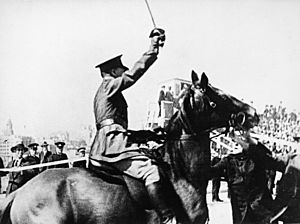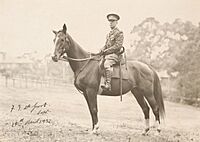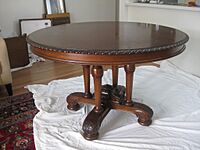Francis de Groot facts for kids
Quick facts for kids
Francis de Groot
|
|
|---|---|

de Groot, 1915
|
|
| Born |
Francis Edward de Groot
24 October 1888 |
| Died | 1 April 1969 (aged 80) Dublin, Ireland
|
| Nationality | |
| Other names | Colonel de Groot, Captain Francis de Groot |
| Education |
|
| Political party | Centre |
| Opponent(s) | Jack Lang |
| Spouse(s) |
Mary Elizabeth Byrne
(m. 1919) |
| Military career | |
| Allegiance | |
| Service/ |
|
| Years of service | 1907–1919 |
| Rank | Captain |
| Unit |
|
| Battles/wars | |
Francis Edward de Groot (born October 24, 1888 – died April 1, 1969) was an Irish-Australian man. He was a member of a group called the New Guard. He became famous for something he did at the opening of the Sydney Harbour Bridge in 1932. He rode a horse and cut the ribbon before the Premier of New South Wales, Jack Lang, could do it. Before this, he worked as an antique dealer and made furniture.
Contents
Early life and army service
Francis de Groot was born in Dublin, Ireland, on October 24, 1888. He went to Blackrock College for his education.
He served in the 15th Hussars during World War I. He fought on the Western Front and received a special ceremonial sword. After the war, he moved to Australia. In Sydney, he became an antique dealer. He also made fine furniture. One of his customers was the Governor-General of Australia, Sir Isaac Isaacs. De Groot made a special chair for him.
Joining the New Guard
In the 1930s, Francis de Groot joined a group called the New Guard. This group had strong political views. They were against the government led by NSW Premier Jack Lang. Many members of the New Guard had served in World War I.
The New Guard wanted to challenge the government's ideas. De Groot helped organize large groups of New Guard members. He believed that using a strong show of force was the best way to respond to their opponents.
The Sydney Harbour Bridge opening
Francis de Groot became very famous on Saturday, March 19, 1932. This was the day the Sydney Harbour Bridge was officially opened. About 300,000 people were there to watch.
De Groot was not part of the official ceremony. But he dressed in his military uniform and rode a horse. He blended in with the police escort party. Premier Jack Lang was about to cut the ribbon to open the bridge. Suddenly, de Groot rode forward. He pulled out his ceremonial sword. He tried to cut the ribbon himself. He declared the bridge open "in the name of the decent and respectable people of New South Wales." Some people say he cut the ribbon. Others say his horse's hooves broke it.
De Groot said he did this because the Governor of New South Wales, Sir Philip Game, had not been invited to open the bridge. The Mayor of North Sydney, Hubert Primrose, was also at the ceremony. He was a member of the New Guard. It is not known if he helped plan de Groot's actions.
Arrest and charges
After the incident, a police officer named W.J. Mackay pulled de Groot from his horse. He arrested him and took his sword. De Groot was first taken to a small police station. Later, he was sent to a special house for mental health checks. He was charged with being "insane."
However, doctors quickly examined de Groot. They found that he was completely sane. The charge of insanity was dropped.
De Groot was then charged with other actions. He was accused of damaging the ribbon. He was also charged with behaving badly in public. The court heard his case. The first charge was dismissed. But the judge found de Groot guilty of behaving offensively in public. He had to pay a fine. The judge said de Groot's actions were "grossly offensive" and "unlawful."
Later, de Groot sued the police for arresting him wrongly. They settled the case outside of court. De Groot received some money. His ceremonial sword was also given back to him.
Mick, the horse
The horse Francis de Groot rode at the opening was named "Mick." Mick was a chestnut horse, about 16.2 hands tall. He belonged to a schoolgirl named Margo Reichard. The leader of the New Guard, Eric Campbell, borrowed Mick from Margo's father. After the bridge event, Mick was taken to the Mounted Police Barracks. Then he was returned to his owner. Sadly, Mick had an accident around 1933 and had to be put down.
Later life
After the court case, Francis de Groot returned to Ireland. He died there on April 1, 1969.
Before he died, de Groot said he wanted his ceremonial sword to return to Australia. In 2004, the sword was found on a farm in County Wicklow, Ireland. It was with de Groot's nephew. There were plans to bring it back to Australia. The National Museum of Australia wanted to display it. However, a company called BridgeClimb Sydney bought the sword instead. BridgeClimb Sydney runs tours across the Harbour Bridge. Students from de Groot's old school, Blackrock College, presented the sword to BridgeClimb Sydney.
Gallery





